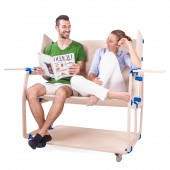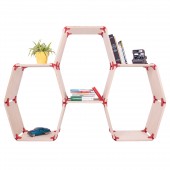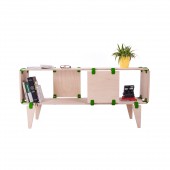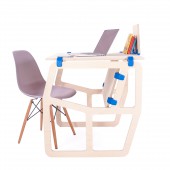
| THE AWARD |
| CATEGORIES |
| REGISTRATION |
| SUBMIT YOUR WORK |
| ENTRY INSTRUCTIONS |
| TERMS & CONDITIONS |
| PUBLICATIONS |
| DATES & FEES |
| METHODOLOGY |
| CONTACT |
| WINNERS |
| PRESS ROOM |
| GET INVOLVED |
| DESIGN PRIZE |
| DESIGN STORE |
| THE AWARD | JURY | CATEGORIES | REGISTRATION | PRESS | WINNERS | PUBLICATIONS | ENTRY INSTRUCTIONS |
Playwood Connector Playwood Is Modular Furniture System by Stefano Guerrieri |
Home > Winners > Design #42637 >Interview |
 |
|
FS: What is the main principle, idea and inspiration behind your design?
SG: The design takes inspiration from a research conducted by Stanford Institute of Design about the set up of co-working spaces and from LEGO bricks, a game that I love since I was a child.
FS: What has been your main focus in designing this work? Especially what did you want to achieve?
SG: In this project, limits have been transformed into values. I had the need to furnish my office an I couldn't find the perfect match: functionality, aesthetics and uniqueness. So I started investing on myself, on my competencies and knowledges. I wanted to create a product easy to be shared with the others and able to be enriched by the creativity of the community.
FS: What are your future plans for this award winning design?
SG: We are plenty of ideas. We will start with new designs and new connectors. We will add IOT elements to the project and we believe that this award can represent a great starting point to develop our project.
FS: How long did it take you to design this particular concept?
SG: Since our background comes from interface design, it took around 18 months to develop the product. We learned a lot of things and we improved our competencies in product design field. The result has been an extreme research of simplicity together with a deep attention to aesthetics. It has been a challenge that we faced with bravery and determination, going out of our comfort zone. This has definitely brought unattended results.
FS: Why did you design this particular concept? Was this design commissioned or did you decide to pursuit an inspiration?
SG: The concept was born to make our working space more creative and functional at the same time. We wanted an easy system that could let us assemble and disassemble on the basis of our needs. I think that everyone has fun in "making" something, so why not to think about a system that lets you create your own project even if you live in an apartment with no specific tools at disposal.
FS: Is your design being produced or used by another company, or do you plan to sell or lease the production rights or do you intent to produce your work yourself?
SG: At the moment we are producing and selling directly our products. We are open to all the possibilities at condition that they respect the concept which stays behind the creation of PlayWood.
FS: What made you design this particular type of work?
SG: Everything. Innovation, curiosity and desire to move forward are only few of the reasons. PlayWood has taken something from every discipline and after a lot of digital I had the willing to create a physical object.
FS: Where there any other designs and/or designers that helped the influence the design of your work?
SG: There are several designers that influence my work, among whom Massimo Vignelli that was saying "If you can't find it, draw it". Or Bruno Munari, founder of the design school I attended. Nils Moorman and HEY DK are my reference point for furniture design.
FS: Who is the target customer for his design?
SG: I thought PlayWood was mainly addressed to offices or co-working spaces, but I discovered that the target is much wider: all the DIY lovers!
FS: What sets this design apart from other similar or resembling concepts?
SG: Aesthetics and functionality: there are no other similar solutions on the market. It's a a product that force you to work with local suppliers, it doesn't break and can be used thousands of times. Furthermore you can constantly log in to new design available in common creative, thanks to the community.
FS: How did you come up with the name for this design? What does it mean?
SG: Play and Ply: a big LEGO for adults and the wood with which we started at the beginning. A little wordplay. We tried to transform materials in a game.
FS: Which design tools did you use when you were working on this project?
SG: We have been using 3D printing softwares that let us quickly create a functional prototype.
FS: What is the most unique aspect of your design?
SG: I would say the internal screw which lets you adjust the thickness of the clamp. In this way you do not have to damage the material, so that it can be re-used many times.
FS: Who did you collaborate with for this design? Did you work with people with technical / specialized skills?
SG: I worked with specialized technicians able to engineer and realize the mold.
FS: What is the role of technology in this particular design?
SG: Technology has been fundamental to the design development. But the product itself doesn't stand out for this: the innovative business model that lets the users interact and contribute to develop the product is the main quality of PlayWood project.
FS: Is your design influenced by data or analytical research in any way? What kind of research did you conduct for making this design?
SG: I studied "Make Space" by Scott Doorley& Witthof, a great inspiration for my work. I analyzed the growing phenomenon of common creative in design and furniture production and how the 3D print could realize connectors functional to the development of my idea.
FS: What are some of the challenges you faced during the design/realization of your concept?
SG: Time. I am used to digital projects and the realization of a physical product it seemed to me endless. But we have believed in it and we made it with our own strengths.
FS: How did you decide to submit your design to an international design competition?
SG: I believed from the beginning in the potential of my project, so I said to myself: now or never. I have a lot of admiration for this award competition and its judgment, so this showed me that my team efforts are paid back.
FS: What did you learn or how did you improve yourself during the designing of this work?
SG: I learned how to use design competencies indirectly, applying my skills to different fields. Massimo Vignelli once said: "Design is one".
FS: Thank you for providing us with this opportunity to interview you.
A' Design Award and Competitions grants rights to press members and bloggers to use parts of this interview. This interview is provided as it is; DesignPRWire and A' Design Award and Competitions cannot be held responsible for the answers given by participating designers.
| SOCIAL |
| + Add to Likes / Favorites | Send to My Email | Comment | View Press-Release |





